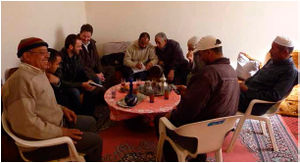Click here to register!
SPIS Toolbox - Define Target Group and Stakeholders

Introduction
The Toolbox on Solar Powered Irrigation Systems (SPIS) is designed to enable advisors, service providers and practitioners in the field of solar irrigation to provide broad hands-on guidance to end-users, policy-makers and financiers. Risks related to system efficiency, financial viability and the unsustainable use of water resources can thus be minimized. The Toolbox comprises informative modules supplemented with user-friendly software tools (calculations sheets, checklists, guidelines). read more
Modules and tools touch upon:
- assessing the water requirements,
- comparing the financial viability,
- determining farm profitability and payback of investment in SPIS,
- sustainably design and maintain a SPIS,
- highlight critical workmanship quality aspects,
- and many more.

style="width: 160px; background-color: rgb(111, 142, 43);"| ►Back to the Module Page
Define Target Group and Stakeholders
The analysis carried out in the preceding steps outline a profile of potential, opportunities, restrictions and risks with regard to the promotion of SPIS. The promoter should also have a good insight into the different forms of financial support for financing SPIS. While some farm household may have access to commercial financing services, others may require a 100% subsidy or a grant to introduce the technology to their farm.
Based on the analysis, the promoter will have to define a specific target group for the technology options promoted. Targeting a specific market does not mean that you are excluding people who do not fit your criteria. Rather, target marketing allows you to focus your marketing dollars and brand message on a specific market that is more likely to buy from you than other markets. This is a much more affordable, efficient, and effective way to reach potential clients and generate business. No one can afford to target everyone.
In case of the SPIS technology this concerns usually medium-sized farm households with good market access and a potential to adapt and intensify their production. Large farm enterprises usually obtain the required information directly through private sector service providers and take investment decisions based on their own business planning (and own equity financing).
Small-scale farmers with poor access to markets and subsistence farm households often cannot cope with the operational requirements and related costs that come with high investments such as induced by SPIS options, even though they may benefit from subsidies or grants. Group schemes with shared pumping installations are an alternative to individual systems in case of smallholders or subsistence producers.This option can also cater for the need to promote disadvantaged and impoverished farming communities that may only have access to communal land. In many cases this women and youth a chance to have land rights, which is often a precondition for them to access credit and equity financing.
The preceding analysis also reveals the identification of important stakeholders for the promotion:
- technology supplier and service providers- to provide proof of well functioning SPIS configurations;
- financing institutions- to give access to funds to finance SPIS;
- agricultural extension services and service providers- to promote the technology and to optimize the productivity and profitability;
- government institutions managing subsidy schemes- to create awareness on support options and improve access to subsidies and other support;
- producer organizations and groups- to create economies of scale for purchasing, selling and accessing information and services;
- donors and NGOs- to support accessing services, improve organizational capacity, and to pilot and demonstrate SPIS configurations.
The identified stakeholders and their role (actual and potential) should be listed as part of the information compilation. Some of these stakeholders may also assume the role as a multiplier of information in the promotion campaign.
Outcome/Product
- Defined range (size) of target farm households and additional criteria (market access, intensification potential);
- List of stakeholders with roles and responsibilities.
Data Requirements
- Farm household / enterprise profiles in the promotion area;
- Functions and functioning of stakeholders.
People/Stakeholders
- Agricultural advisor / development practitioner.
Important Issues
- Not every farm enterprise can absorb an investment in modern irrigation technologies due to limited market access and potential to adapt and intensify production.
- Group schemes with shared pumping facilities can be a feasible approach for subsistence producers, disadvantaged communities and for women and young people with access to resources.




















